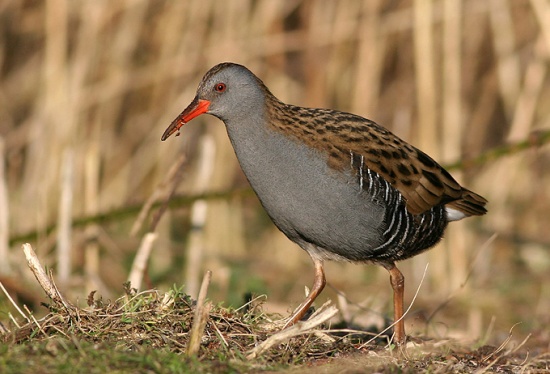(Imp sizes) |
Nutcracker (talk | contribs) (more details) |
||
| Line 3: | Line 3: | ||
==Identification== | ==Identification== | ||
25–28 cm (9¾-11 in)<br /> | 25–28 cm (9¾-11 in)<br /> | ||
| − | Upperparts olive-brown with broad, black streaks, | + | Upperparts olive-brown with broad, black streaks, grey face, breast and flanks, black-and-white barring on rear flanks, and greyish [[Topography#Heads|supercilium]]. |
| + | |||
| + | ====Similar species==== | ||
| + | [[Brown-cheeked Rail]] is very similar, differing in browner, less grey cheeks and flanks; it can usually be separated on range, but overlaps locally with Water Rail on their wintering grounds in southern Asia. Young juvenile [[Common Moorhen]] is sometimes mistaken for Water Rail by novice birders. | ||
==Distribution== | ==Distribution== | ||
| − | Breeds throughout most of the [[ | + | Breeds throughout most of [[Europe]] except for the northern half of [[Scandinavia]]; also western and central [[Asia]], and northernmost [[Africa]]. Western and southern populations are resident, while northeastern birds are migratory. Winters mostly within the southern and western half of the breeding range but also more widely in north Africa and southwestern Asia, and a few reaching east to [[India]] and southeastern [[China]]. |
==Taxonomy== | ==Taxonomy== | ||
[[Image:PRM 25161.jpg|thumb|350px|right|Photo by {{user|angletarn|angletarn}}<br />[[Brandon Marsh]], [[Warwickshire]], October 2009]] | [[Image:PRM 25161.jpg|thumb|350px|right|Photo by {{user|angletarn|angletarn}}<br />[[Brandon Marsh]], [[Warwickshire]], October 2009]] | ||
[[Brown-cheeked Rail]] used to be included in this species as a subspecies. | [[Brown-cheeked Rail]] used to be included in this species as a subspecies. | ||
====Subspecies==== | ====Subspecies==== | ||
| − | There are | + | There are three subspecies<sup>[[#References|1]]</sup>: |
| − | *''R. a. hibernans'' - [[Iceland]] | + | *''R. a. hibernans'' - formerly bred [[Iceland]], wintered Iceland (around thermal springs) and [[Ireland]]; extinct c.1965 due to habitat loss and introduced American Mink. |
*''R. a. aquaticus'' - [[Western Palearctic]] | *''R. a. aquaticus'' - [[Western Palearctic]] | ||
*''R. a. korejewi'' - [[Iran]] to north-western [[China]]; winters to [[India]] and southern [[China]] | *''R. a. korejewi'' - [[Iran]] to north-western [[China]]; winters to [[India]] and southern [[China]] | ||
==Habitat== | ==Habitat== | ||
| − | + | Reedbeds, marshes, etc. | |
==Behaviour== | ==Behaviour== | ||
A skulker, this bird is much more often located by its piglet-like squeals. Food includes both invertebrates and plant materials like seeds. | A skulker, this bird is much more often located by its piglet-like squeals. Food includes both invertebrates and plant materials like seeds. | ||
Revision as of 23:18, 11 April 2017
- Rallus aquaticus
Identification
25–28 cm (9¾-11 in)
Upperparts olive-brown with broad, black streaks, grey face, breast and flanks, black-and-white barring on rear flanks, and greyish supercilium.
Similar species
Brown-cheeked Rail is very similar, differing in browner, less grey cheeks and flanks; it can usually be separated on range, but overlaps locally with Water Rail on their wintering grounds in southern Asia. Young juvenile Common Moorhen is sometimes mistaken for Water Rail by novice birders.
Distribution
Breeds throughout most of Europe except for the northern half of Scandinavia; also western and central Asia, and northernmost Africa. Western and southern populations are resident, while northeastern birds are migratory. Winters mostly within the southern and western half of the breeding range but also more widely in north Africa and southwestern Asia, and a few reaching east to India and southeastern China.
Taxonomy
Brown-cheeked Rail used to be included in this species as a subspecies.
Subspecies
There are three subspecies1:
- R. a. hibernans - formerly bred Iceland, wintered Iceland (around thermal springs) and Ireland; extinct c.1965 due to habitat loss and introduced American Mink.
- R. a. aquaticus - Western Palearctic
- R. a. korejewi - Iran to north-western China; winters to India and southern China
Habitat
Reedbeds, marshes, etc.
Behaviour
A skulker, this bird is much more often located by its piglet-like squeals. Food includes both invertebrates and plant materials like seeds.
Vocalisation
<flashmp3>Rallus aquaticus (song).mp3</flashmp3>
Listen in an external program
References
- Clements, J. F., T. S. Schulenberg, M. J. Iliff, D. Roberson, T. A. Fredericks, B. L. Sullivan, and C. L. Wood. 2016. The eBird/Clements checklist of birds of the world: v2016, with updates to August 2016. Downloaded from http://www.birds.cornell.edu/clementschecklist/download/
Recommended Citation
- BirdForum Opus contributors. (2024) Water Rail. In: BirdForum, the forum for wild birds and birding. Retrieved 3 May 2024 from https://www.birdforum.net/opus/Water_Rail
External Links





